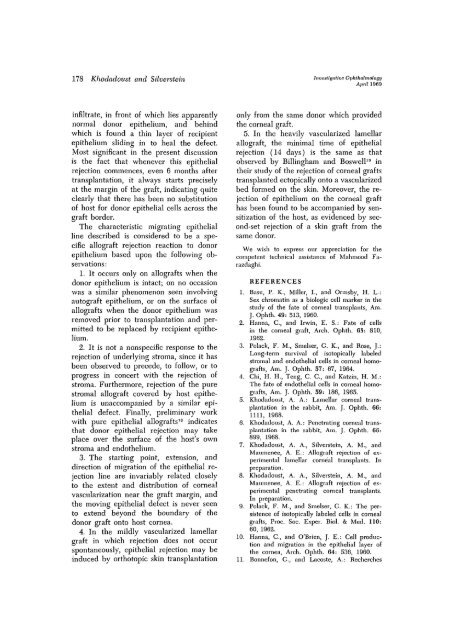The survival and rejection of epithelium in experimental corneal ...
The survival and rejection of epithelium in experimental corneal ...
The survival and rejection of epithelium in experimental corneal ...
Create successful ePaper yourself
Turn your PDF publications into a flip-book with our unique Google optimized e-Paper software.
178 Khodadoust <strong>and</strong> Silverste<strong>in</strong> Investigative Ophthalmology<br />
April 1969<br />
<strong>in</strong>filtrate, <strong>in</strong> front <strong>of</strong> which lies apparently<br />
normal donor <strong>epithelium</strong>, <strong>and</strong> beh<strong>in</strong>d<br />
which is found a th<strong>in</strong> layer <strong>of</strong> recipient<br />
<strong>epithelium</strong> slid<strong>in</strong>g <strong>in</strong> to heal the defect.<br />
Most significant <strong>in</strong> the present discussion<br />
is the fact that whenever this epithelial<br />
<strong>rejection</strong> commences, even 6 months after<br />
transplantation, it always starts precisely<br />
at the marg<strong>in</strong> <strong>of</strong> the graft, <strong>in</strong>dicat<strong>in</strong>g quite<br />
clearly that there has been no substitution<br />
<strong>of</strong> host for donor epithelial cells across the<br />
graft border.<br />
<strong>The</strong> characteristic migrat<strong>in</strong>g epithelial<br />
l<strong>in</strong>e described is considered to be a specific<br />
allograft <strong>rejection</strong> reaction to donor<br />
<strong>epithelium</strong> based upon the follow<strong>in</strong>g observations<br />
:<br />
1. It occurs only on allografts when the<br />
donor <strong>epithelium</strong> is <strong>in</strong>tact; on no occasion<br />
was a similar phenomenon seen <strong>in</strong>volv<strong>in</strong>g<br />
autograft <strong>epithelium</strong>, or on the surface <strong>of</strong><br />
allografts when the donor <strong>epithelium</strong> was<br />
removed prior to transplantation <strong>and</strong> permitted<br />
to be replaced by recipient <strong>epithelium</strong>.<br />
2. It is not a nonspecific response to the<br />
<strong>rejection</strong> <strong>of</strong> underly<strong>in</strong>g stroma, s<strong>in</strong>ce it has<br />
been observed to precede, to follow, or to<br />
progress <strong>in</strong> concert with the <strong>rejection</strong> <strong>of</strong><br />
stroma. Furthermore, <strong>rejection</strong> <strong>of</strong> the pure<br />
stromal allograft covered by host <strong>epithelium</strong><br />
is unaccompanied by a similar epithelial<br />
defect. F<strong>in</strong>ally, prelim<strong>in</strong>ary work<br />
with pure epithelial allografts ls <strong>in</strong>dicates<br />
that donor epithelial <strong>rejection</strong> may take<br />
place over the surface <strong>of</strong> the host's own<br />
stroma <strong>and</strong> endothelium.<br />
3. <strong>The</strong> start<strong>in</strong>g po<strong>in</strong>t, extension, <strong>and</strong><br />
direction <strong>of</strong> migration <strong>of</strong> the epithelial <strong>rejection</strong><br />
l<strong>in</strong>e are <strong>in</strong>variably related closely<br />
to the extent <strong>and</strong> distribution <strong>of</strong> <strong>corneal</strong><br />
vascularization near the graft marg<strong>in</strong>, <strong>and</strong><br />
the mov<strong>in</strong>g epithelial defect is never seen<br />
to extend beyond the boundary <strong>of</strong> the<br />
donor graft onto host cornea.<br />
4. In the mildly vascularized lamellar<br />
graft <strong>in</strong> which <strong>rejection</strong> does not occur<br />
spontaneously, epithelial <strong>rejection</strong> may be<br />
<strong>in</strong>duced by orthotopic sk<strong>in</strong> transplantation<br />
only from the same donor which provided<br />
the <strong>corneal</strong> graft.<br />
5. In the heavily vascularized lamellar<br />
allograft, the m<strong>in</strong>imal time <strong>of</strong> epithelial<br />
<strong>rejection</strong> (14 days) is the same as that<br />
observed by Bill<strong>in</strong>gham <strong>and</strong> Boswell 19 <strong>in</strong><br />
their study <strong>of</strong> the <strong>rejection</strong> <strong>of</strong> <strong>corneal</strong> grafts<br />
transplanted ectopically onto a vascularized<br />
bed formed on the sk<strong>in</strong>. Moreover, the <strong>rejection</strong><br />
<strong>of</strong> <strong>epithelium</strong> on the <strong>corneal</strong> graft<br />
has been found to be accompanied by sensitization<br />
<strong>of</strong> the host, as evidenced by second-set<br />
<strong>rejection</strong> <strong>of</strong> a sk<strong>in</strong> graft from the<br />
same donor.<br />
We wish to express our appreciation for the<br />
competent technical assistance <strong>of</strong> Mahmood Farazdaghi.<br />
REFERENCES<br />
1. Basu, P. K., Miller, I., <strong>and</strong> Ormsby, H. L.:<br />
Sex chromat<strong>in</strong> as a biologic cell marker <strong>in</strong> the<br />
study <strong>of</strong> the fate <strong>of</strong> <strong>corneal</strong> transplants, Am.<br />
J. Ophth. 49: 513, 1960.<br />
2. Hanna, C, <strong>and</strong> Irw<strong>in</strong>, E. S.: Fate <strong>of</strong> cells<br />
<strong>in</strong> the <strong>corneal</strong> graft, Arch. Ophth. 63: 810,<br />
1962.<br />
3. Polack, F. M., Smelser, G. K., <strong>and</strong> Rose, J.:<br />
Long-term <strong>survival</strong> <strong>of</strong> isotopically labeled<br />
stromal <strong>and</strong> endothelial cells <strong>in</strong> <strong>corneal</strong> homografts,<br />
Am. J. Ophth. 57: 67, 1964.<br />
4. Chi, H. H., Teng, C. C, <strong>and</strong> Katz<strong>in</strong>, H. M.:<br />
<strong>The</strong> fate <strong>of</strong> endothelial cells <strong>in</strong> <strong>corneal</strong> homografts,<br />
Am. J. Ophth. 59: 186, 1965.<br />
5. Khodadoust, A. A.: Lamellar <strong>corneal</strong> transplantation<br />
<strong>in</strong> the rabbit, Am. J. Ophth. 66:<br />
1111, 1968.<br />
6. Khodadoust, A. A.: Penetrat<strong>in</strong>g <strong>corneal</strong> transplantation<br />
<strong>in</strong> the rabbit, Am. J. Ophth. 66:<br />
899, 1968.<br />
7. Khodadoust, A. A., Silverste<strong>in</strong>, A. M., <strong>and</strong><br />
Maumenee, A. E.: Allograft <strong>rejection</strong> <strong>of</strong> <strong>experimental</strong><br />
lamellar <strong>corneal</strong> transplants. In<br />
preparation.<br />
8. Khodadoust, A. A., Silverste<strong>in</strong>, A. M., <strong>and</strong><br />
Maumenee, A. E.: Allograft <strong>rejection</strong> <strong>of</strong> <strong>experimental</strong><br />
penetrat<strong>in</strong>g <strong>corneal</strong> transplants.<br />
In preparation.<br />
9. Polack, F. M., <strong>and</strong> Smelser, G. K.: <strong>The</strong> persistence<br />
<strong>of</strong> isotopically labeled cells <strong>in</strong> <strong>corneal</strong><br />
grafts, Proc. Soc. Exper. Biol. & Med. 110:<br />
60, 1962.<br />
10. Hanna, C, <strong>and</strong> O'Brien, J. E.: Cell production<br />
<strong>and</strong> migration <strong>in</strong> the epithelial layer <strong>of</strong><br />
the cornea, Arch. Ophth. 64: 536, 1960.<br />
11. Bonnefon, G., <strong>and</strong> Lacoste, A.: Recherches
















